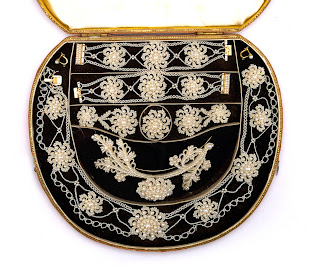Perhaps you remember my last article about the Beadworkers Guild Bead challenge in which I told you that I'd come back about it... I was waiting for photos of our group entry to become available. Apologies for the quality... I made a screenshot of the photos in the digital July journal, which is all I can show, together with some bits and pieces made by me and some of the participants (but not placed "in situ").
We chose "English Country Garden" so that each member could make something. Boy have I been busy with it! It takes a lot of time to write a tut, so imagine so many more for a common project.
Our leader Sylvia thought of making a carousel to best display the 3 distinct couplets of the song in 3 different scenes. How to make the carousel and how to put it all together, including gates between the scenes was all studied and made by Jenny Wilson. The entire group of designers and beaders got together with them through zoom to throw ideas at them. This is how the bench, bird "bath", insect hotel, gates, a buddleia tree and even a pond came on the table... The song got broken down into lists of flowers, birds, insects and greenery. The participants could then choose what they wanted to make. A spreadsheet to keep track of who chose to do what was kept up to date. It took a while before someone accepted to bead spiders, ha ha.
The question "how will it fit in the box" came up quite early, but we couldn't really find the answer... until Sylvia suggested a brilliant solution: magnets.
 Luckily I had patterns already made which could be used -
Luckily I had patterns already made which could be used -  grass, lady bugs, spiders, a dragonfly, lily of the valley,
leaves, a bee... Sylvia had (and made) a moth and
forget-me-not's. From Liz Thornton (who participated) and Jill Devon's book, The Beader's Floral, we used a pansy and vines; and I based my mini-roses on a tiny flower in there. It is
still is available through the BWG website.
grass, lady bugs, spiders, a dragonfly, lily of the valley,
leaves, a bee... Sylvia had (and made) a moth and
forget-me-not's. From Liz Thornton (who participated) and Jill Devon's book, The Beader's Floral, we used a pansy and vines; and I based my mini-roses on a tiny flower in there. It is
still is available through the BWG website. Bénédicte Damnet (and her husband Jean-Luc) made graphs for the birds and the insects with Beadographer. Those who made these had to adapt a bit and did a great job. Here some of the beautiful results:
 |
| Gillian L. |
 |
| Sharron S. |
 |
| Gillian W. |
 We needed daffodils, phlox (creeping), lilies, lupines, leaves, hollyhocks and
snowdrops (which I designed). Foxgloves were designed and made by Helen
McIntyre. We left out meadow sweet (fillipendula) and stocks
(matthiola), but had huge panicles of buddleia flowers instead.
We needed daffodils, phlox (creeping), lilies, lupines, leaves, hollyhocks and
snowdrops (which I designed). Foxgloves were designed and made by Helen
McIntyre. We left out meadow sweet (fillipendula) and stocks
(matthiola), but had huge panicles of buddleia flowers instead.
Some designers made one of a kind additions. Jess Hayman beaded an incredible bench, a fountain and a pond... masterpieces!!
Helen McIntyre made miniature fox gloves. Jenny Wilson made the buddleia flowers and the gates, I beaded a gnome, a hedgehog, and a larger lily, daffodils, and vines.
We were more than 30 beaders in the group, most from the UK but also from the USA and elsewhere. Some did a lot, some less, some had unfortunate life events preventing them from accomplishing what they wanted to do... in the end, we can say that we are all tremendously proud of the result.
 |
| Bench by Jess |
There was no other group entry this year, which was quite a
bummer. Winning by default is not really a win, but the whole group
is chuffed to bits with the end result.

























